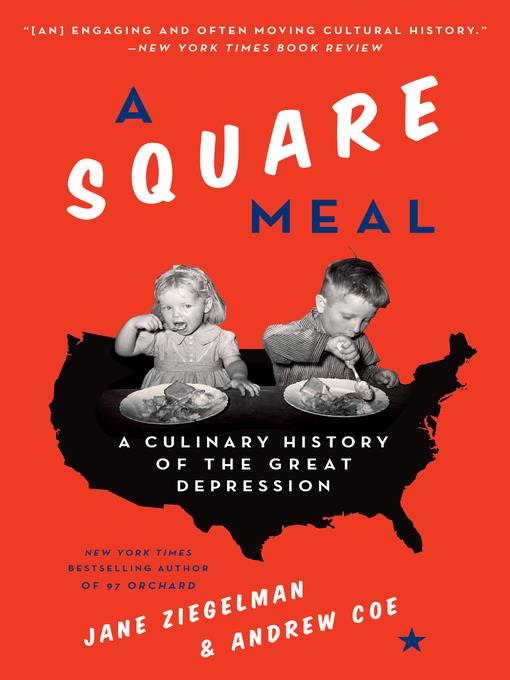
A Square Meal
A Culinary History of the Great Depression
کتاب های مرتبط
- اطلاعات
- نقد و بررسی
- دیدگاه کاربران
نقد و بررسی

May 30, 2016
This absorbing history explores what American’s ate—and, even more, didn’t eat—during the Great Depression, an economic upheaval that devastated agriculture and food budgets. Husband-and-wife food historians Coe (Chop Suey) and Ziegelman (97 Orchard) revisit an era when dire poverty and widespread hunger prompted a raft of food innovations. As bread lines lengthened, political leaders vacillated over the provisioning of food to destitute families while dodging accusations of fostering dependency and laziness. Welfare supports such as food stamps and the school lunch program inaugurated the enduring bureaucratization of food. The period also witnessed a sea change in how Americans thought about food, shifting the focus from taste and abundance to nutrition as scientists and home economists sought to prescribe adequately nutritious diets from the cheapest possible foods—after Eleanor Roosevelt adopted a scientifically engineered economy menu devised at Cornell University, the White House was generally thought to serve the worst fare in Washington—and new convenience inventions such as frozen vegetables revolutionized cooking. Coe and Ziegelman have written an engaging social history illustrated throughout with historically authentic recipes. Even if the period cuisine doesn’t make the reader’s mouth water, the vivid recreation of American eating at a historical crossroads is engrossing. Photos. Agent: Jason Yarn, Jason Yarn Literary.

June 15, 2016
A history of the struggle to put food on American tables during the Great Depression."Food, like language, is always in motion, propelled by the same events that fill our history books," write culinary experts Coe (Chop Suey: A Cultural History of Chinese Food in the United States, 2009) and Ziegelman (97 Orchard: An Edible History of Five Immigrant Families in One New York Tenement, 2010). By using food as a unifying theme, the authors give a fresh slant to the familiar but complicated history of one of America's most difficult eras. They deftly connect food to science, technology, and commerce as well as political, cultural, and social movements, assembling a thought-provoking mix of personal stories, statistics, and historical events. After the 1929 crash, President Herbert Hoover claimed "business was on sound footing" while New York City breadlines served 85,000 meals per day to the destitute from all levels of society. A domino effect of unemployment and hunger spread across the nation, exacerbated by droughts and floods. "The poor and how they should be treated," and who is "deserving" and "undeserving" in the hierarchy of food distribution were questions that were part of a national conversation that resonates today. The fear that providing food for the hungry would destroy any incentive to work hindered relief efforts as presidents Hoover and Roosevelt approached the juggernaut of feeding a nation from opposite ends of the political spectrum. As jobs and farms dried up, people were on the move looking for work and sustenance. Menus, recipes, and first-person accounts of folks struggling to get a meal put readers at the heart of the crisis. Among the heroes was an army of professional women from the Bureau of Home Economics who sallied forth armed with budgetary and nutritional advice, determined to educate masses of women on cooking methods, low-cost balanced diets, gardening, and new kitchen technology. Their efforts influenced the culinary arts for decades to come. A highly readable, illuminating look at the many ramifications of feeding the hungry in hard times.
COPYRIGHT(2016) Kirkus Reviews, ALL RIGHTS RESERVED.

June 15, 2016
Accomplished culinary historians Ziegelman (97 Orchard) and Coe (Chop Suey) team up to create a highly digestible food history of the Great Depression. The book begins with the abundance of U.S. provisions before the Depression: those high-calorie, traditional meat and pie meals baked on the farm. The 1930s, however, ushered in a new era of rationing, breadlines, and bare-bones meals. This account reveals the kinds of dishes people prepared. Many recipes are provided throughout. The diverse historical narrative details not only the kitchen table but also the wider politics and social dynamics of the period. It further traces the emerging nutritional studies that guided many New Deal operations. Particularly illuminating are the portions relating to the sudden growth of breadlines in 1930, and the ways in which many folks scraped together just enough flour and milk to survive the hard times. Excerpts from primary documents give readers a sense of the various and rich voices from the Depression. VERDICT This thought-provoking work concerning the most important commodity during America's greatest economic crises will have wide appeal.--Jeffrey Meyer, Mt. Pleasant P.L., IA
Copyright 2016 Library Journal, LLC Used with permission.

























دیدگاه کاربران